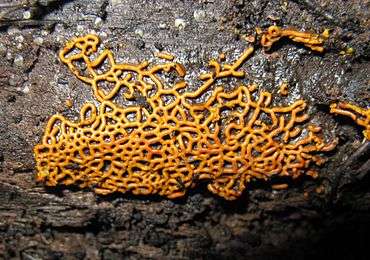Plasmodium (life cycle)

A plasmodium is a living structure of cytoplasm that contains many nuclei, rather than being divided into individual cells each with a single nucleus.
Plasmodia are best known from slime molds, but are also found in parasitic Cnidospora, and some algae such as the Chlorarachniophyta.
Structure
A plasmodium is an amoeboid, multinucleate and naked mass of cytoplasm that contains many diploid nuclei. The resulting structure, a coenocyte, is created by many nuclear divisions without the process of cytokinesis which in other organisms pulls newly-divided cells apart.[1] In some cases, the resulting structure is a syncytium, created by fusion of cells.
Taxonomic distribution
The term plasmodium, introduced by Leon Cienkowski,[2] usually refers to the feeding stage of slime molds; these are macroscopic myxomycetes.[3]
The multinucleate developmental stages of some intracellular parasites, namely Microsporidia (now in Fungi) and Myxosporidia (now in Cnidaria), former cnidosporans, are also sometimes called plasmodia.[4]
Similarly, in Rhizaria, the ameboid, multinucleate protoplasts of some Cercozoan algae, e.g. Chlorarachniophyta, are called plasmodia. These lack cell walls; the syncytia are created by cell fusion.[4] Some plasmodiophorids and haplosporidians are other multinucleated rhizarians.[5]
References
- ↑ Sharma OP. (1988). "4. Myxomycota". Textbook of Fungi. Boston: McGraw Hill Higher Education. pp. 33–48. ISBN 0-07-460329-9. Retrieved January 31, 2013.
- ↑ Kuznicki, L. & Dryl, S. (1987). Leon Cienkowski. Acta Protozoologica 26 (1): 1-2, .
- ↑ Berg, Linda (2008). Introductory Botany: Plants, People, and the Environment (2nd ed.). Belmont CA: Thomson Corporation. p. 398. ISBN 0-03-075453-4.
- 1 2 Hoek, C. van den, Mann, D.G. and Jahns, H.M. (1995). Algae An Introduction to Phycology. Cambridge University Press, Cambridge. ISBN 0-521-30419-9.
- ↑ Brown MW, Kolisko M, Silberman JD, Roger AJ. (2012). Aggregative Multicellularity Evolved Independently in the Eukaryotic Supergroup Rhizaria. Current Biology, Volume 22, Issue 12, 1123-1127.